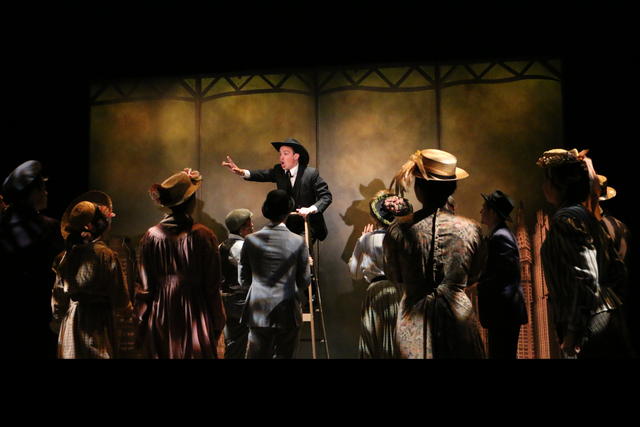by Monica Charline Brown
Known by many for his fantasy novel series The Chronicles of Narnia, C.S. Lewis is among the top twentieth century writers of Christian apologetics. Although he identified as an atheist early in life, Lewis converted to Christianity by his thirties. As a member of the Anglican Church, he used writing as a means to defend a systematic and analytic portion of Christian theology.
The Screwtape Letters was originally written as a satiric and epistolary novel, written from Screwtape’s point of view. Screwtape, a satanic senior tempter, addresses his problematic demon-in-training nephew, also known as Wormwood. The Fellowship for Performing Arts’ stage adaption of The Screwtape Letters, now playing at the Pearl Theatre, follows the book in a conscientious and consistent manner. The production is directed by Max McLean, who starred in the original off-Broadway run at the Westside Theatre, which ran three hundred and nine performances. The renewal of the show is the second installation in FPA’s inaugural New York theatrical season.
Lights up are in a dining hall in Hell. The audience is transported to the graduation banquet of the Tempters’ Training College for Young Devils, where a skulls and bones background pays homage to the Catacombs of Paris. The prologue is derived from Screwtape Proposes a Toast, Lewis’s miniature sequel essay written seventeen years after the initial novel was published. Screwtape, taken on by the commanding Brent Harris, uses his address to counsel a rising class of devils. On the performance reviewed here (January 14), Marissa Molnar dynamically portrayed the role of Toadpipe, a demented creature who colorfully responds to Screwtape’s speech. Toadpipe is also portrayed during this production by Karen Eleanor Wight and Shiloh Goodin (pictured).
Following the brief discourse, the scene opens up to include the raked stage, styled as Screwtape’s lux office in Hell. The main premise of the circulation of letters is Wormwood’s task to secure a position in Hell for his “patient,” a young British man. Each spirit is assigned a human to haunt on Earth, since human souls are Hell’s primary source of food. If a chosen soul is lost to Heaven, the demon itself is consumed as punishment. Throughout the perverted and warped correspondences, the Devil is referred to as “Our Father Below” and the Lord is charged as the “Enemy.” As Screwtape processes each fresh letter, he dictates the text of his reply to his sidekick and secretary, Toadpipe. Signing off as “Your Affectionate Uncle, Screwtape” in a slightly similar, punctuated way each time, Toadpipe never fails to rip the paper out, wad it up, and scamper across the stage. Once Toadpipe reaches the topsy-turvy ladder, the creature climbs to the top and submits the letter through a pneumatic tube device, such as those used in office buildings in the first part of the 20th century.
With one-sided communication, the contrast between Wormwood and Screwtape is brought to the forefront. While Wormwood naïvely falls into desiring stereotypical ways of turning the man wicked, Screwtape advises a much more measured and learnèd path. Screwtape and Wormwood volley back and forth on the themes of lust-versus-love, pride-versus-humility, gluttony-versus-sustainability and ultimately, the threat of war. Screwtape viscerally experiences Wormwood’s patient’s transition to Christianity, marriage to a Christian girl, and involvement with the Second World War.
Although the material verges on repetitive and pedantic at times, Brent Harris, in the role of Screwtape, keeps the energy flowing through his full-embodied performance and masterful musicality of the language. Realizing Hell has no time or space, Harris dominates and navigates quite an emotional journey. Molnar’s movement and acrobatic ability serve the character of Toadpipe well, striking a mixture of modern dance and mime. Her mischievous use of onomatopoeia as well as her capacity to be entranced by the myriad of characters Screwtape references should be noted.
Cameron Anderson’s set design provides visual interest in addition to a playground for Screwtape and Toadpipe to experience primeval connection. Jesse Klug’s lighting design was luscious and stirring. The original composition and sound design by John Gromada set up both hellacious noise and a theme to tie the letters together beautifully. The lighting and sound design worked together to produce a sharp, crisp, yet artistic product. Lastly, Michael Bevin’s costume design was a standout, donning Screwtape in a militaristic, elegant fashion in contrast to the flashy, scaly, and feathery stone-printed creature of Molnar’s character which, under certain lighting, looked like it had glowing embers under the surface.
For a short evening that will engage your mind, body, and spirit, head on over to the Pearl Theatre. C.S. Lewis fans, religious enthusiasts, theologians, and non-believers alike will indeed find a take away from this production.
The Screwtape Letters. Through Sunday, January 24 at the Pearl Theatre Company (555 West 42nd Street between 10th and 11th Avenues). www.pearltheatre.org
* Photos by Joan Marcus























